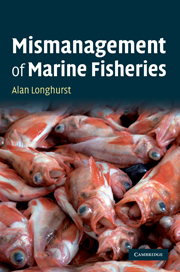Book contents
- Frontmatter
- Contents
- Preface
- 1 From certainty to doubt in fishery science
- 2 The ecological consequences of the exceptional fecundity of teleosts
- 3 Indeterminate growth, negative senescence and longevity
- 4 Marine ecosystems: their structure and simulation
- 5 The natural variability of fish populations and fisheries
- 6 Has sustainability in fishing ever been achieved?
- 7 What is the real state of global fish populations?
- 8 The mechanics of population collapse
- 9 Why don't some fish populations recover after depletion?
- 10 Is the response of the fishery science community appropriate?
- 11 Conclusion: sustainability can be achieved rarely and only under special conditions
- Index
5 - The natural variability of fish populations and fisheries
Published online by Cambridge University Press: 05 July 2014
- Frontmatter
- Contents
- Preface
- 1 From certainty to doubt in fishery science
- 2 The ecological consequences of the exceptional fecundity of teleosts
- 3 Indeterminate growth, negative senescence and longevity
- 4 Marine ecosystems: their structure and simulation
- 5 The natural variability of fish populations and fisheries
- 6 Has sustainability in fishing ever been achieved?
- 7 What is the real state of global fish populations?
- 8 The mechanics of population collapse
- 9 Why don't some fish populations recover after depletion?
- 10 Is the response of the fishery science community appropriate?
- 11 Conclusion: sustainability can be achieved rarely and only under special conditions
- Index
Summary
‘By the fall of 1957, the coral ring of Canton Island, in the memory of man ever bleak and dry, was lush with the seedlings of countless tropical trees and vines . . . great rafts of sea-borne seeds and heavy rains had visited her barren shores . . . elsewhere about the Pacific . . . the year had been one of extraordinary climatic events. Hawaii had its first recorded typhoon, the seabird-killing El Niño visited the Peruvian coast, the ice went out of Point Barrow at the earliest time in history and on the Pacific's Western rim, the tropical rainy season lingered six weeks beyond its appointed term.’
Preface – CalCOFI Report 7, 1960The brief review of the structure of marine ecosystems presented in Chapter 4 treated these as static entities which, of course, they are not: this chapter is intended to review the processes by which ecosystems respond to the changing environment of the ocean. The strong contrast in the internal structure of relatively open marine and relatively closed terrestrial ecosystems is paralleled by equally different characteristic variability and uncertainty in the external forcing that is characteristic of the marine and terrestrial habitats.
Agricultural scientists are very well aware of the critical consequences of changing weather patterns and also of regional patterns of soils and sub-soils, because an understanding of these factors is essential for the management of farming and animal husbandry. Although fisheries are also dependent on the pattern of change in ocean conditions that is induced at all time scales by variable weather conditions, and also at all spatial scales by the geometry of land masses, the importance of the resulting patterns of variability – for some reason – was late in entering mainstream fisheries science texts (I have already alluded to John Gulland's 1974 The Management of Marine Fisheries, because it encapsulated the thinking of many fisheries scientists in the days when there was great confidence in the future of their endeavour).
- Type
- Chapter
- Information
- Mismanagement of Marine Fisheries , pp. 79 - 118Publisher: Cambridge University PressPrint publication year: 2010



